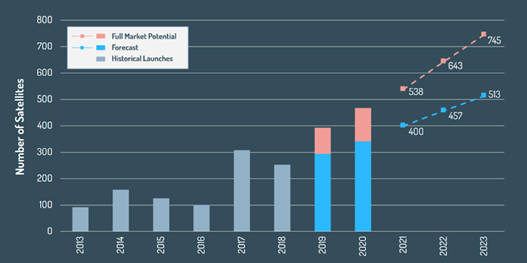Competition Details
Competition Overview
This provides description of all the major components of the competition, and includes references to additional material where necessary.
For all details of the competition, please see the 2019-2020 Rules and Requirements document.
Mission Background and Scenario
New Space is based on a philosophy of creating less expensive satellites in shorter periods of time, thanks to falling costs and technological developments of miniaturisation spacecraft equipment. Nanosatellites have demonstrated that cheaper, off-the-shelf technology still allows for large amounts of scientific return, while maintaining good quality results. Nanosatellites have been a key contributor to the commercialisation of space, where forecasts predict that by 2022, up to 75% of all nanosatellites are forecasted to be in orbit for commercial reasons.

Figure 1: Graph of the number of nanosatellites in the market (Source: Spaceworks - 2019 Nano/Microsatellite Market Forecast, 9th Edition).
The versatility of nanosatellites continues to increase, entering applications in Earth observation, geolocation and logistics, signal monitoring, communications and Internet of Things (IoT) and general scientific applications. Enabling a greater accessibility to space, significant development of miniaturised technology is being achieved. Their capabilities continue to be pushed to it limits. One example being the first interplanetary nanosatellite mission, MarCO (Mars Cube One): two data-relay communications cubesats for NASAs Mars Insight mission (launched in 2018).
With an increased interest in interplanetary nanosatellite missions, joined with the long-standing goal of humans returning to the Moon, establishing a lunar gateway for the eventual goal of the first crewed mission to Mars, the competition focuses on a lunar satellite mission. The main objective to acquire as much scientific data from historic lunar landmarks and judge the effectiveness a nanosatellite payload can achieve.
Mission Tasks
The challenge is to design a payload system for a 3U cubesat that can detect and analyse different sources of data signatures from a simulated lunar environment. The competition is separated into two main phases: a research & design phase and a build & test phase. The research & design phase ends when teams submit their Critical Design Review (CDR) report to their reviewers. Once all CDR reports have been reviewed and marked, the 5 best teams will be selected to progress to the build & test phase, where they will receive an OC 3U beeKit platform to integrate to their payload. Click here to read more about OC’s beeApp and beeKit products.
Teams will be able to conduct Hardware in the Loop (HIL) testing, alongside OC’s beeApp software, which shall also be provided. By using beeKit, a payload computer is not required and therefore reduces the cost and complexity of payload design. Further information of the competition structure can be seen in the Rules and Requirements document.
A high-level lunar nanosatellite mission must be designed in conjunction with payload design and must be submitted with the CDR report. The objective is to state what orbit the satellite should be injected into to maximise revisit times of historic lunar sites/landmarks, for example the Apollo, Luna and Chang’e lander modules. A final list shall be released in the coming weeks. Teams will be able to utilise Open Cosmos’ beeApp software for this, which will be made available mid-late February 2020 to assist in design and analysis of the lunar mission.
Competition Challenge Day
The challenge day consists of two components, an attempt to complete the objectives inside a mystery room and a 10-15 minutes presentation.
Teams shall be tested inside a mystery room that shall simulate a lunar environment. The satellite (beeKit + integrated payload) will be suspended in the centre of the mystery room by a piece of string/rope, allowing for rotation in one axis (see Appendix D.3 in the Rules and Requirements document for more information about the hook interface). Teams will then have 30 minutes to detect, pinpoint and identify as many different sources of information as possible, which will be spread out across the room. Additional points will be awarded if teams are able to acquire details of the sources/objects of interest or are able to decode a message being transmitted from the different sources. Listed below are the final list of sources that will be present on the day that teams should prepare for.
1. Objects of interest
2. Heat sources of ranging temperatures
3. Light sources of ranging wavelength and intensity
4. Electromagnetic signals (912 - 921MHz frequency range)
Full Details and test definition of how the tasks above shall be tested and marked can be found below in Appendices C.7 and C.8 in the Rules and Requirements document.
Post-Competition Opportunities
Once the competition has finished, SSPI are interested in publishing the five best CDR reports, accompanied with a brief write-up on each team and their members. Furthermore, there will be the opportunity for up to 3 teams to be invited to speak on the SSPI podcast, sharing your experiences throughout the competition.
Open Cosmos has confirmed that the team awarded Best Payload Performance shall have an article written about their work, as well as visibility of their success in their social media. OC will also host a Space Mission Design Workshop the following academic year at the winning team’s university. In addition, for those final five teams selected, OC would like to publish each team’s hard work (including code) to their Open Cosmos Academy, as well as a wiki page explaining their design, so it is accessible to anyone interested and future competitors can improve previous designs.
